As technology evolves, is independent animation being left behind? These and other concerns are currently being addressed by Pierre Hert.
This article contains an exclusive QuickTime movie clip. If you don't have QuickTime get it now as you won't want to miss a snippet of Pierre Hébert's groundbreaking work!
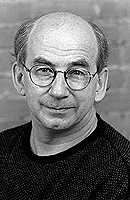
Pierre Hébert.
Walter Benjamin wrote his seminal article, The Work of Art in the Age of Mechanical Reproduction, as a response to the technological innovations such as cinema and photography that permitted, through reproduction, mass access to previously sacred or unique works of art. One of the interesting questions Benjamin asked was just how this reproduction would change the process of creating and reacting to art. Owing to digital technology, we are at a stage, where we must perhaps return to Benjamin if only to consider the effect of this new technology on art.
In a 2000 article for the Holland Animation Film Festival, Canadian animator, Pierre Hébert argued that animation, in its fervent desire to protect and promote itself, has instead become an inward-looking practice: "It has let itself drift into an embittered, corporatist and willful isolation, valuing good craftsmanship and good animation and slightly losing sight of the philosophical position that underlies the act of animating." Similarly, where animation once had a meaningful, but undefined relationship with cinema and especially experimental film, this is no longer the case today despite the obvious, but unspoken influence of animation on almost every fiber of cinema. In the rush to protect and promote itself, Hébert suggests that 'auteur' animation has isolated itself from other plastic arts.
Animation, and specifically independent or 'auteur' animation, which is often the feeding ground for any and all new trends in commercial animation, is at a dead end. Stylistic and narrative innovations certainly continue, but all within the same abiding walls; walls that have been pushed as far as they will bend.
In recent years, Hébert has put his words into action. While his interest in alternative methods of creating and presenting animation goes back to the early 1980s, his recent performance piece, Between Science and Garbage, is suggesting radical new possibilities for viewing, creating and defining animation. As it stands at the moment, Pierre Hébert appears to be the most visible voice capable of leading animation out of its almost forty year period of isolationism.
Much to the chagrin of me, myself and I, outside of the animation festival crowd, very few people even know whom Pierre Hébert (let alone, Svankmajer, Pärn and The Quays) is; so let's go back to Hébert's beginnings as an artist.
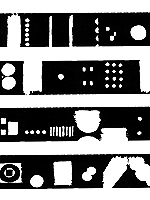
Op Hop. Director: Pierre Hébert; Producer: National Film Board of Canada. © NFB.
The Abstract Years
As a child, Hébert was always interested in drawing and painting. For years he wondered where the desire came from. Neither of his parents was artistically orientated. His father worked in the steel industry as an office worker, then an accountant and later as a dossier builder to help land contracts. It was only recently that Hébert found the seeds of his creativity. While courting his grandmother, Hébert's grandfather used to send her a painted postcard every week. "I saw the about 50 postcards. It showed that he had talent. So I have this small seed."
Not surprisingly when Hébert wanted to attend a Fine Arts school, his parents frowned upon it and insisted he was better off enrolling in University. Hébert studied anthropology and archeology, but visual arts remained foremost in his mind. Then came Norman McLaren who indirectly planted the next artistic seed in Hébert's mind. "I had friends at school who had started to wash out 8mm films and draw on it and the idea of that came from McLaren. I saw it and thought it was cool." Hébert began making his own cameraless films and was excited by both the process and result. Meantime, a producer at the National Film Board of Canada was putting on screenings of experimental films at museums and other venues. Increasingly Hébert began to see the connection with animation.
Meantime, Hébert was calling up McLaren and asking for advice about creating scratched soundtracks. McLaren would give Hébert film leader with which to practice. Hébert later brought the results for McLaren's feedback. Obviously impressed with this new talent, McLaren referred Hébert to producers Wolf Koenig and Bob Verrall, who had just started a student program and were looking for students to hire. Hébert was hired. Consequently, Hébert and the NFB began what would be a thirty-five year relationship.
Initially Hébert did not find the NFB very compelling. While he was given encouragement to do his own thing, he also worked on sequences for documentaries and other service orientated work for various government ministries. One of the most interesting projects he directed was a film called Population Explosion. This warning against overpopulation was not much, but it did feature an original soundtrack by jazz legend, Ornette Coleman. Hébert spent most of his evenings and weekends at the NFB working on his own films. Two of these "spare time" films were Op Hop (1966) and Opus 3 (1966). These almost violent abstract films use geometrical shapes -- which randomly flicker and float across the screen -- to explore theories of optics and perception. Hébert's first "official" NFB film Around Perception (1968), was a continuation of the theories explored in the first two films.

Between Dog and Wolf. Director: Pierre Hébert; Producer: René Jodoin. © NFB.
From the start, Hébert's work was oddly enough -- given that he is deeply rooted in the work of McLaren and Rene Jodoin -- an anomaly. While McLaren undoubtedly influenced many of the young animators of this period (e.g. Ryan Larkin, Francine Desbiens), he had virtually no influence on the direction of the Board. During the 1960s, the NFB concentrated on "cel" animation and assembly line structures. Fortunately, the creation of a French animation division led to the hiring of former McLaren colleague, Rene Jodoin, who from the beginning insisted on reawakening the McLaren heritage. It was within this new environment that Hébert began making his own films.
Personal Politics
In the 1970s, clearly influenced by the increasing political climate of his era, Hébert began to combine his artistic innovation with political commentary. Following a cinematic attack on the commercialization of Christmas called Pere Noel, Pere Noel, Hébert made Between Dog and Wolf (1978). Hébert mixed a variety of techniques (including cut-out and scratch animation) into a multi-level narrative that merged Brecht dialogue with somber images of people waiting at a bus station. Alas, the animator's output began to appear reductive and didactic during this phase -- not to mention that its formal complexity distanced the work from those whom Hébert claimed it was speaking to and for.
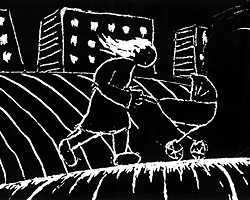
Souvenirs de guerre. Director: Pierre Hébert; Producer: Robert Forget. © NFB.
After taking a sabbatical from the Film Board in 1979, Hébert returned to the NFB rejuvenated and with a clearer sense of his artistic direction. Souvenirs du Guerre (1982) marks a turning point in Hébert's early career as he moves away from both abstract formal and political concerns to more personalized, tangible politics.
Motivated by the birth of his son, Etienne, and the war in Afghanistan, Hébert wonders how his child will survive in a harsh violent world where children are little more than "leaves on a tree." Hébert uses scratch, cut-out animation and live-action images to create an unstable and ominous world always on the brink of violence and destruction. While the rigidity of Hébert's earlier films occasionally rear their ugly heads (the link between family-labour-war is a little too simple), in general, Hébert's vision is more flexible and constructive. Hébert understands that war and politics are a complex infrastructure involving labor, the family and the individual. As he shows us, we are participants in our own destruction, but do we have the power or ability to participate in our salvation?
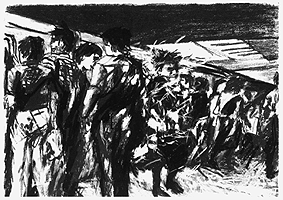
Le Metro. Director: Pierre Hébert; Producer: Robert Forget. © NFB.
As early as 1984, Hébert was involved in multimedia performances. Usually they involved a projected film accompanied by improvised sounds. The challenge for Hébert was how to create a way of improvising the images. Eventually he started experimenting with film loops in the projector. In 1985, Hébert began to extend this improvisational style to his films. Le Metro (1985), for example, was collaboration between Hébert and musicians Robert Lepage and René Lussier. Each artist improvised his impressions of the dehumanizing effects of the urban subway's underground world.
Increasingly encouraged by his improvised results, Hébert made a film version of his collaborative performances called Lettre D'Amour. Lettre D'Amour evolved out of a series of small workshops that Hébert and his wife and writer, Sylvie Massicotte, were involved in. Subjects were chosen out of a hat. One subject that seemed to offer infinite possibilities was a love letter and the variety of emotions and thoughts confronting a person as they await its arrival. Hébert and Massicotte expanded the performances to include dance (Louise Bedard) and music (Robert Marcel Lepage). Lettre D'Amour is a film of one of those performances.
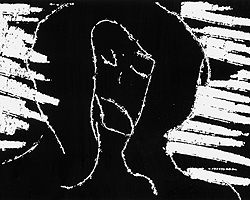
La Lettre D'Amour. Director: Pierre Hébert; Producer: Robert Forget. © NFB.
Akin to a jazz performance, each performer has his/her turn to riff on the subject. The result however is interesting but flawed. Lettre D'Amour fails to capture the spontaneity, tension and freedom of the performance setting. The dance, in particular, is reduced to a poorly flickering image on a TV screen, adding nothing to the piece. Let's just say that Lettre is an interesting experiment and a step in Hébert's progression toward performance animation.
In 1996, Hébert completed his first feature film, La Plante Humaine (The Human Plant). The film, which combines scratch animation and live-action, follows the rather uneventful life of a retired librarian named Michel. His days are spent walking his dog, reading about Leonardo Da Vinci, reading a book of traditional African stories, and watching television (specifically newscasts). He acquires a variety of knowledge about the world but he does not do anything with it (he's essentially a couch potato).
Interestingly, Hébert plays off his old activist days as we expect a critique of the Gulf War, television or this inactive protagonist. However, Hébert does not succumb to these easy targets of attack. Michel and his life are merely observed and we, like Michel, are left to figure out our own solutions.
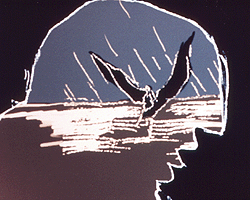
La Plante Humaine. Director: Pierre Hébert; Producer: Freddy Denaës, Yves Leduc. © NFB.
What hope is there if we can no longer actively participate in, let alone change, the direction of our vast world? The answer, for Hébert, is modest. In the final scene, Michel leaves his house and goes to the library where he shares his stories with a group of children. By talking to each other, Hébert seems to suggest that sharing our knowledge and experiences offer hope for the present and future. However, Hébert again throws a loop into what we're seeing because Michel has now become a well-dressed professorial live-action character. The live-action character, it seems, is merely a projection of Michel's imagination. If this is a part of his imagination, has he even left the house or does he remain planted in the seeds of his imagination?
 An AWN exclusive! View an extract of Between Science and Garbage, a multimedia performance by Pierre Hébert and Bob Ostertag as performed in Montreal on October 19, 2001. Courtesy of Pierre Hébert.
An AWN exclusive! View an extract of Between Science and Garbage, a multimedia performance by Pierre Hébert and Bob Ostertag as performed in Montreal on October 19, 2001. Courtesy of Pierre Hébert.
In having Michel dream in live-action, Hébert reverses our tendency to see live-action images as genuine or authentic. In doing so he reminds us (á là Walter Benjamin) that all images are constructed from a particular point of view.
Time for a Change
After thirty-five years, Hébert left the National Film Board of Canada in 1999 to concentrate on his independent artistic career and specifically performance art. During 1999 and 2000, Hébert traveled to a variety of International Festivals (Switzerland, Canada, Holland) to present a series of scratch animation performances (usually accompanied by a musician). Over the past year, he began working with noted musician Bob Ostertag on a new type of performance that would be created and performed using digital technology. The result is Between Science and Garbage, an hour-long multimedia performance about the disposability of culture.
What Hébert and Ostertag are creating is, within the context of independent animation, radical. Ostertag has collected a variety of music samples on a Mac PowerBook. Using a program called Max, Ostertag is able to do virtually anything he wants to the sounds. Meantime, Hébert has a digital video camera hooked up to a small homemade animation stand. The camera is connected to Hébert's PowerBook. Hébert also has about fifty images stored along with a handful of QuickTime movies (taken primarily from news footage). Hébert can alter the sequence, pace, texture and color of these images. Hébert's performance will consist of a combination of these archived images with about 80% improvised live animation (ranging from cut-out, object, paint on glass, chalk on board, and basic drawn animation). The title of the performance refers at once to the disposability of the technology (the computer could crash during the screenings) and the content (which changes with each performance).
In artistic terms, this is by no means revolutionary. Hollywood has made digital features, and music has long collaborated with film in a performance context. Yet within the world of independent animation, Hébert's work is radical. The process of creation is no longer hidden from the viewer in a different time and space. The animator performs, not for a "mechanical contrivance," but an audience. While you could suggest a return to sacred art because of the uniqueness of each performance, we should remember that each performance is also disposable. There is nothing to prevent Hébert from having his computer crash and losing all his images. So while each work is unique, there's this sort of casual attitude that shrugs if it's lost. The collaborative aspect of the performance enhances the ability to create something new. Music is no longer subservient to the animation.
One of the more interesting aspects of Hébert's work is the liberation of time. 24 frames per second has for the most part remained the defining slice of time for many animators. Now 24 frames is merely an option among many: "When I first encountered the parameter controls in the first versions of the Max software, for example, the control button of the speed of the loop in buffer-1, it was like a mental landslide because all my animator skill had been up to that point locked to a fixed value, that is 24 frames per second." Suddenly Hébert discovered that the program (which was designed for music) could measure in 1000th of a second. "I could set the different parallel flows of events happening in the computer at independent values in 1000th of seconds, also independent of the frame rate it would be sliced into by the video projector. The elimination of 24 frames as a measure of time provides an opportunity for animators to fundamentally change the way they construct their work.
Economically, the performance also has many advantages. The digital technology means that the work is mobile and compact. After the initial cost of the computer and essential gadgets, there is no need to strike prints, no shipping dynamics to negotiate, and no projectionist to shout at.
This is not to say that animators should all rush out and pick up laptops. This is not an either/or situation or a criticism of existing animations. Instead Hébert's work is merely opening a door to new possibilities in animation. "I just feel like trying to assess in a radical and experimental way what is already widely happening in the audiovisual media as a whole. And also trying to understand that historically and find a ground to help define new conditions of artistic creation when dealing with technology." At the very least it means that those animators who've often cringed while watching their film, often wishing they could go back and change this or that, will perhaps soon be in a position where they can do just that.
Chris Robinson is the artistic director of the Ottawa International Animation Festival and founder and director of SAFO, the Ottawa International Student Animation Festival. He is editor of the ASIFA News. Robinson has curated film programs and served on festival juries throughout the world. He writes a monthly column ("The Animation Pimp") for Animation World Network and has written numerous articles on animation. His iconoclastic tendencies have led him to be called the "John Woo of diplomacy" and most recently, "the enfant terrible of animation" by Take One magazine. He is currently working on a book about something.







